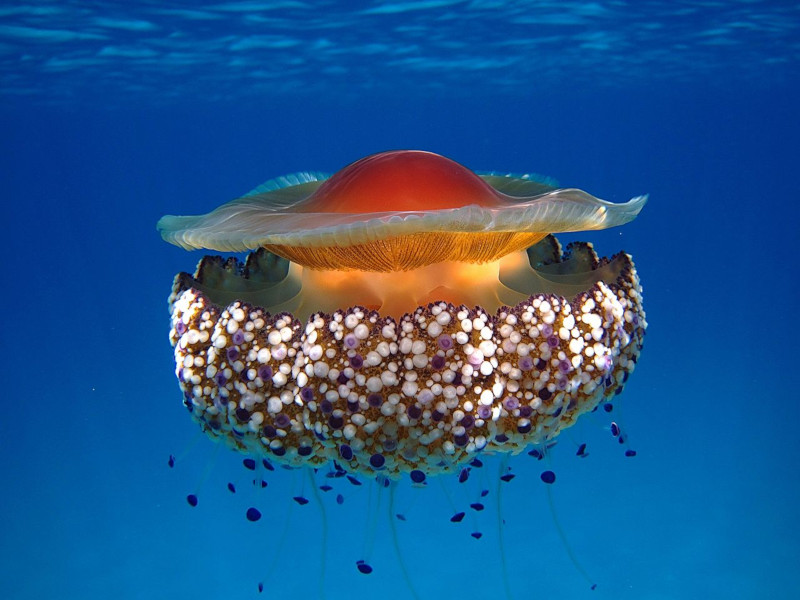
Fried Egg Jellyfish Facts
- Most notably, several different species of jellyfish, in various parts of the world, go by the common name of Fried Egg Jellyfish. The species referred to in this article, however, bears the cumbersome scientific name of the Cotylorhiza tuberculata. But, the amazing creature also possesses yet another common name. That holds true due to the fact that some people know the animal as the Mediterranean Jellyfish.
- Fortunately for humans, this magnificent Cnidarian separates itself from its relatives in an important way. That’s because, unlike the majority of cnidarians, its sting poses no particular threat to humans. Quite unfortunately, the reverse does not remain the case. That’s because its annual blooms interfere with human water sport activities. As a result, vast numbers are forcibly removed from their habitat.
- Luckily for it, however, the Fried Egg Jellyfish reproduces in great numbers. As a result of this biological proclivity, its number appear to remain stable, for the moment. Therefore, the IUCN currently has no listing for this creature. But that could change in the foreseeable future. It doubtless facing the same potential threats as other sea-dwellers. These potential dangers mainly consist of pollution, and of course, climate change.
Related Articles
Fried Egg Jellyfish Physical Description
First of all, regardless of other factors involved, the overall size of the amazing Fried Egg Jellyfish must be noted. That’s because, its incredible appearance notwithstanding, the remarkable species ranks as a roughly average-sized cnidarian.
This statement holds true due to the maximum attained size of individuals observed to date. That holds true because the largest studied specimens attained a disk diameter of about 16 in (40 cm). However, most individuals only average a measurement of about 6.7 in (17 cm).
In addition to this, its central dome remains surrounded by a deep-set ring. The numerous transparent cilia it develops often vary significantly in appearance between individuals. Many have a rounded end. Further, these also achieve differing lengths, creating a layered effect.
However, the appearance of the central disk of the Fried Egg Jellyfish obviously remains its most remarkable physical feature. This holds true due to its coincidental resemblance to a fried egg. This, therefore, understandably, serves as the source of its common name.
- Kingdom: Animalia
- Phylum: Cnidaria
- Class: Scyphozoa
- Order: Rhizostomeae
- Family: Cepheidae
- Genus: Cotylorhiza
- Species: C. tuberculata
Fried Egg Jellyfish Distribution, Habitat, and Ecology
Firstly, the magnificent cnidarian known to many as the Fried Egg Jellyfish inhabits a moderately large range. That’s because it appears in three separate seas of the world. These consist of Aegean Sea, the Adriatic Sea, and the Mediterranean Sea.
However, the wondrous creature currently remains most numerous in one highly specific region. Further, that region consists of certain portions of the Mediterranean Sea. There, it appears most commonly in the waters near the countries of Italy, Monaco, and Greece, in Europe.
Furthermore, this marvelous animal inhabits the portion of the worlds’ seas known as the pelagic zone. Within that region, however, it moves back and forth from shallow to deeper regions. That’s because it approaches the surface at night, mainly to feed.
The truly gorgeous Fried Egg Jellyfish has a diet consistent with most other known cnidarians. As a result, it feeds mainly on extremely tiny sea life. Most commonly, this consists of a combination of zooplankton and phytoplankton.
Species Sharing Its Range
Check out our other articles on 8 South American Geological Marvels, Crowned Eagle, Caddo Lake, Thorny Dragon, Bleeding Tooth Fungus, Emperor of India Butterfly, Southern Elephant Seal
